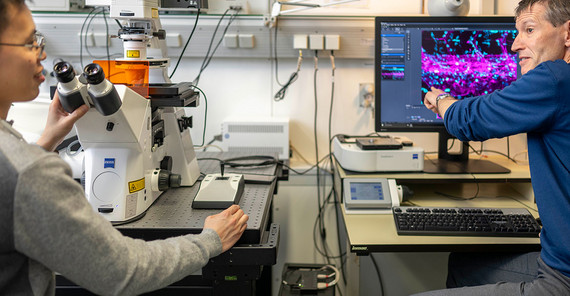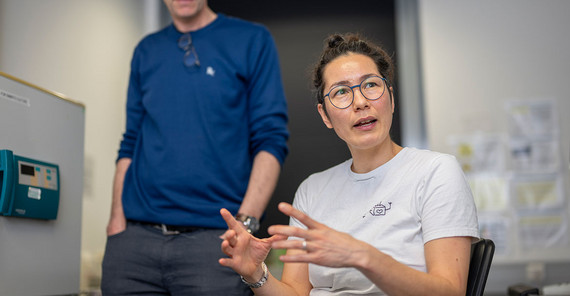“Sometimes, patients with CCM-3 already have numerous lesions in the brain as children,” says Prof. Dr. Salim Seyfried, who personally knows some tales of woe. “The lesions can occur in all parts of the brain, including parts that are inoperable. Many people are waiting desperately for a cure for this disease.”
The physiologist and his team achieved an important breakthrough in the fight against the disease a few years ago. From approximately 6,000 chemical compounds, they were the first to identify active substances that could potentially prevent CCM-related adhesions in human blood vessel cells. “At an industrial level, this process has already been somewhat automated,” says postdoc Claudia Rödel. “We did it manually here.” It was a broad-based screening process that took several years and was like looking for the proverbial needle in a haystack. In a more recent study, the researchers also discovered two other promising active substances.
The tested substances also include those from common medicines used against all kinds of ailments, such as high blood pressure or mental illnesses. Using fish eggs, and later also human vascular cells, the biologists investigated whether these compounds have an effect against vascular anomalies. In a further step, a shortlist of these substances was specifically investigated to determine whether they have an influence on the cause of CCM at the molecular level.
Blood flow: a sparring partner for vessel cells
After years of research, the culprit in the case of CCM is no longer unknown: the so-called transcription factor KLF2. “This KLF2 is perhaps the best-researched biomechanical regulator,” Seyfried says. “But for CCM, initially nobody had it on their radar.”
Van-Cuong Pham, PhD student at the Department of Biology and Biochemistry, explains what happens on the molecular level. “In principle, KLF2 reacts to the blood flow,” Pham explains. “If it is sufficiently high, KLF2 is activated and protects the vascular cells against mechanical stress.” The researchers suspect that the shear stress acting on blood vessels has an influence on vascular health.
“Through our research, we know that KLF2 can not only protect but also make you sick.” This is because, in the genome of CCM patients – who often come from real stroke families –serious “spelling errors” cause even vessels with low blood flow to have high concentrations of the transcription factor. However, this cannot bind to the DNA of the vascular cells and protect them, as it does in healthy people. The chromobox protein homolog 7 (CBX7) prevents it from doing so and suddenly causes KLF2 to do things that harm rather than benefit the cells.
"The affected cells then divide more frequently, and, in some cases, the shape of the vessels also changes drastically," says Rödel, describing what you see through the microscope. In laboratory experiments, the team was able to demonstrate that two substances with the abbreviations MS37452 and MS351 interrupt the mechanism that has gotten out of control by blocking CBX7.
Hope for a medical treatment of CCM
However, such CBX7 inhibitors do not occur in nature. “These are synthetic compounds developed by the US pharmacologist Ming-Ming Zhou from Mount Sinai Hospital," Prof. Seyfried explains. “We want to use these active ingredients for therapeutic applications. The goal is to have a drug specifically against CCM.”
Such a “pill against stroke” could be administered so that acute vascular growths recede or, when used preventively, possibly do not develop in the first place. It would eliminate the need for delicate brain operations in which diseased blood vessels are removed before they burst and cause a stroke. MRI examinations, which are designed to detect cell growths in high-risk patients, would also become a thing of the past. A normal life would be possible for those affected.
The findings of the researchers in Potsdam go far beyond the discovery of active ingredients. Research into the causes of CCM raises new questions, especially about the blood flow dynamics and their effects on the cells. And why do CCM patients have the causative gene mutation in every cell of their body but develop the blackberry-shaped growths exclusively in the brain?
The research on CCM also contributes to a better understanding of other diseases. Many are based on a genetic mutation that cannot be well researched in humans. Instead, animal cells and organisms are needed to observe the pathogenic processes as well as potential active substances. Especially in the creation of disease models in zebrafish eggs, the department has acquired a lot of expertise in the course of its research on CCM.
The researchers have come a good deal closer to their goal of beating the insidious hereditary disease. However, further research, for example on metabolization, side effects, and general tolerability, is needed before an approved drug against CCM can be launched – and investors see the production of such a niche medicament as a chance. “This could be a start-up that produces an approved drug,” Prof. Seyfried says.
Salim Seyfried has been a Professor of Animal Physiology at the University of Potsdam since 2014.
This text was published in the university magazine Portal – One 2025 “Children” (PDF).



